Do you have a question about the Carrier 40RM and is the answer not in the manual?
Covers aspects like moving, storage, and rigging before installation.
Instructions for transferring and storing the unit to maintain its condition.
Guidance on using shipping skids and lifting methods for safe handling.
Provides general installation guidelines and clearance requirements.
Instructions for removing shipping skid and inspecting for damage.
Guidance on placing the unit considering clearances and support.
Information on installing isolators for noise reduction.
Covers accessing panels, fan motor lubrication, and bearings.
Includes fan belts, rotation, pulley alignment, and drive adjustments.
Maintenance of condensate drains and return-air filters.
Procedures for coil freeze protection, removal, and cleaning.
Details about factory-installed options like GC, HC, TC, YC, ED, FD, RD, WD.
Information on packaging types: Standard Domestic and Standard Export.
Lists voltage designations available for the units.
Discusses options for moving panels for alternate return air intake locations.
Advice on installing isolators for quiet operation and unit support.
Details on refrigerant pipe connection sizes and brazing recommendations.
Information on chilled water piping connection sizes.
Describes additional access holes required for certain units and their locations.
Shows typical evaporator coil connections for vertical and horizontal installation.
Illustrates the correct placement for the TXV sensing bulb.
Lists requirements for filter driers for specific heat pump systems.
Refers to Fig. 4 for access hole locations and lists fittings required for piping.
Refers to Fig. 9 for a typical installation example of chilled water piping.
Information on accessing coil vents and drains and preventing freeze-up.
Explains the importance and method of installing a trap in the condensate drain line.
Guidance on pitching the drain line and using clean-out plugs.
Instructions for adjusting the condensate drain pan slope.
Lists the standard components included in motor and drive packages.
Refers to service section for instructions on changing fan rotation, speed, and adjusting drives.
Advises checking unit data plate and providing a disconnect switch of adequate size.
Instructions for field-converting motors for different voltage operations.
Details on wiring thermostats to the fan contactor control box.
Provides electrical data including voltage limits, HP, FLA, and minimum circuit amps.
Explains how to calculate voltage imbalance and important considerations.
Instructions for installing duct flanges and making canvas connections for discharge.
Guidance on routing return-air ductwork and using slip joints.
Mentions connecting to field-installed economizer.
Refers to service section for filter replacement instructions.
Checklist for ensuring unit is supported, adjusted, and securely fastened.
General list of inspection and maintenance tasks for the unit.
Notes on removing panels for service access and sealing.
Table listing recommended lubricants for fan shaft bearings.
Instructions for adjusting fan shaft position and tightening locking collars.
Guidance on checking fan belt deflection based on motor size.
Instructions for adjusting motor pulley to change fan speed.
Steps to drain coils and add antifreeze for freeze protection.
Provides fan performance data at various airflow and static pressure conditions.
Details fan performance for higher external static pressures.
Shows pressure drop values for factory-supplied filters based on airflow.
Presents fan performance data in SI units for various airflow and pressure conditions.
Details SI fan performance for higher external static pressures.
Provides factory-supplied filter pressure drop in Pascals based on airflow.
Step-by-step guide for removing and installing air filters, including using a filter hook.
Fields for recording model and serial numbers for preliminary info.
Steps to check outdoor unit, power supply, ground wire, and wiring connections.
Verifies thermostat and fan control wiring connections and terminal tightness.
Confirms proper drainage, filter placement, and fan alignment/tension.
Checks for solenoid valves, leak checks at various components, and valve positions.
Verifies air bleeding, leak checks at compressors, chillers, and valves.
Guides on measuring line-to-line voltages and calculating imbalance.
Instructions to record evaporator fan speed and various operating measurements.
Verifies the compressor oil level sight glasses.
Covers aspects like moving, storage, and rigging before installation.
Instructions for transferring and storing the unit to maintain its condition.
Guidance on using shipping skids and lifting methods for safe handling.
Provides general installation guidelines and clearance requirements.
Instructions for removing shipping skid and inspecting for damage.
Guidance on placing the unit considering clearances and support.
Information on installing isolators for noise reduction.
Covers accessing panels, fan motor lubrication, and bearings.
Includes fan belts, rotation, pulley alignment, and drive adjustments.
Maintenance of condensate drains and return-air filters.
Procedures for coil freeze protection, removal, and cleaning.
Details about factory-installed options like GC, HC, TC, YC, ED, FD, RD, WD.
Information on packaging types: Standard Domestic and Standard Export.
Lists voltage designations available for the units.
Discusses options for moving panels for alternate return air intake locations.
Advice on installing isolators for quiet operation and unit support.
Details on refrigerant pipe connection sizes and brazing recommendations.
Information on chilled water piping connection sizes.
Describes additional access holes required for certain units and their locations.
Shows typical evaporator coil connections for vertical and horizontal installation.
Illustrates the correct placement for the TXV sensing bulb.
Lists requirements for filter driers for specific heat pump systems.
Refers to Fig. 4 for access hole locations and lists fittings required for piping.
Refers to Fig. 9 for a typical installation example of chilled water piping.
Information on accessing coil vents and drains and preventing freeze-up.
Explains the importance and method of installing a trap in the condensate drain line.
Guidance on pitching the drain line and using clean-out plugs.
Instructions for adjusting the condensate drain pan slope.
Lists the standard components included in motor and drive packages.
Refers to service section for instructions on changing fan rotation, speed, and adjusting drives.
Advises checking unit data plate and providing a disconnect switch of adequate size.
Instructions for field-converting motors for different voltage operations.
Details on wiring thermostats to the fan contactor control box.
Provides electrical data including voltage limits, HP, FLA, and minimum circuit amps.
Explains how to calculate voltage imbalance and important considerations.
Instructions for installing duct flanges and making canvas connections for discharge.
Guidance on routing return-air ductwork and using slip joints.
Mentions connecting to field-installed economizer.
Refers to service section for filter replacement instructions.
Checklist for ensuring unit is supported, adjusted, and securely fastened.
General list of inspection and maintenance tasks for the unit.
Notes on removing panels for service access and sealing.
Table listing recommended lubricants for fan shaft bearings.
Instructions for adjusting fan shaft position and tightening locking collars.
Guidance on checking fan belt deflection based on motor size.
Instructions for adjusting motor pulley to change fan speed.
Steps to drain coils and add antifreeze for freeze protection.
Provides fan performance data at various airflow and static pressure conditions.
Details fan performance for higher external static pressures.
Shows pressure drop values for factory-supplied filters based on airflow.
Presents fan performance data in SI units for various airflow and pressure conditions.
Details SI fan performance for higher external static pressures.
Provides factory-supplied filter pressure drop in Pascals based on airflow.
Step-by-step guide for removing and installing air filters, including using a filter hook.
Fields for recording model and serial numbers for preliminary info.
Steps to check outdoor unit, power supply, ground wire, and wiring connections.
Verifies thermostat and fan control wiring connections and terminal tightness.
Confirms proper drainage, filter placement, and fan alignment/tension.
Checks for solenoid valves, leak checks at various components, and valve positions.
Verifies air bleeding, leak checks at compressors, chillers, and valves.
Guides on measuring line-to-line voltages and calculating imbalance.
Instructions to record evaporator fan speed and various operating measurements.
Verifies the compressor oil level sight glasses.
| Brand | Carrier |
|---|---|
| Model | 40RM |
| Category | Air Cleaner |
| Language | English |
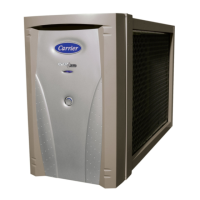
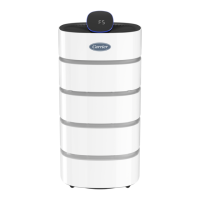
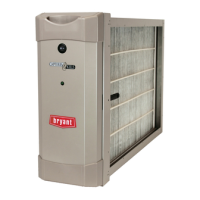




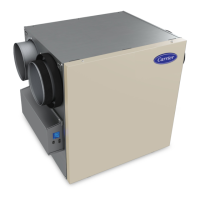

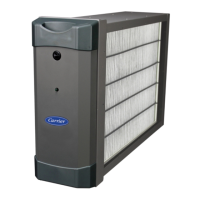

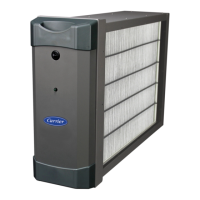
